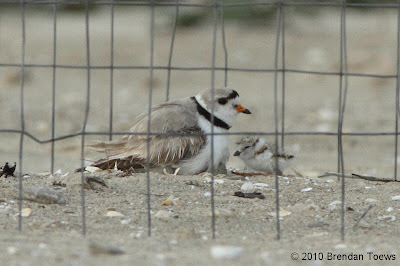
The nesting season for Endangered Piping Plovers is almost done at Sauble Beach, but if you’ve been following the updates from volunteer guardians Kim and Brendan Toews (April 15 – May 12, May nest update, June 11-22) we’ll be finishing the saga this week.
23 June, 2010
Nest 2 (M1 & F2): All 4 chicks brooded regularly, but for very short periods of time, perhaps due to the mild temperatures. A Ring-billed Gull got too close to the chicks. The female piped and the chicks froze, then she flew directly at the gull and landed right at its feet. The male flew in and both adults took on the gull in a furious display of flying and pecking. The gull soon left the area.
The chicks foraged up to 60 metres away from the perimeter and to the water’s edge. Adults moved the chicks by running to different locations. Chicks caught up, fed and brooded when cool. Adult birds moved again and the process was repeated.
The male’s shifts are much shorter than the female’s – on average 15 minutes vs 32 minutes.
Nest 3 (F1 & M5): Please note that M3 (male from Nest 3) is not the new mate of F1 as previously reported. Leg band combinations have been confirmed. We do indeed have a new male, M5 with F1. The female was observed standing over the scrape and then later on sitting in it.
25 June, 2010
We were fortunate to have a visit from two Grade 2 classes. The classes were split into three groups. One of our guardians read the Piping Plover story, Ahmed and the Nest of Sands; a second guardian showed the students an abandoned scrape and had them act out plover behaviours; and a third guardian told the students about many other interesting Piping Plover facts. These Grade 2 classes had a great time!
Nest 2 (M1 & F2): Switchovers occurred approximately every 45-60 minutes with the female taking the longer shift. Four chicks feeding well south of perimeter. One chick foraged along the shoreline while moving towards the beach-going public. Female piped, the chick stopped and moved towards her.
26 June, 2010
Nest 2 (M1 & F2): Four chicks foraged along the shoreline during the rain. Adults chased a crow from the area. Later on an alarm call was given by the adults and the chicks froze. No predator was observed at the time. Much later, a merlin flew over the area and into the dunes behind Nest 1. The female watched the merlin, but did not sound an alarm. Both adults remained close to the chicks. One adult seemed to be drawing people and predators (gulls) away, while the other set up an area to brood the chicks. Guardians have observed this behaviour over other years.
Nest 3 (F1 & M5): Male was sitting on the scrape with the female inside the perimeter fencing.
27 June, 2010
Nest 2 (M1 & F2): The young fed and moved all over the beach. Lots of rain, therefore the chicks brood a bit more often. Crows and gulls in the area. The adults switched over approximately every hour. An additional plover in the area, but it was chased off by the adults.
Nest 3 (F1 & M5): Fox in the area, but it did not pay attention to the plover nest. Incubating may have begun at this nest. The female and male switched over every 2 hours and took similar amounts of time incubating. The adults stayed on the scrape during heavy rainfall.
Additional bird: One single male on the beach.
28 June, 2010
Nest 2 (M1 & F2): Cool temperatures, fog, wind and high waves. Chicks spent more time brooding than feeding. Both adults brooded chicks which was the first time this year that this particular behaviour was observed.
Nest 3 (F1 & M5): High winds and waves have affected the shoreline. Waves moved close to the scrape, but stopped short of covering it. The pair continued to incubate. One bird fed along the shoreline and the other sat on the scrape.
29 June, 2010
Nest 2 (M1 & F2): High winds, but the plovers seemed to be fine.
Canadian Wildlife Service and the Ontario Ministry of Natural Resources brought in a team of experts to band the chicks. They did it quickly in order to minimize the stress on these young plovers. All 4 chicks were banded successfully. The leg band combination is yet to be confirmed, but guardians reported: upper left metal, lower left dark blue, upper right orange. Band colours used are determined by the master banders and are unique to each nest of chicks. Each chick in the nest is banded the same. Should any of these chicks be seen in future years they’ll be easily identified as hatched in 2010 at Sauble Beach, north nest. In Michigan, the adult birds are often captured and another leg band is added so they can be identified as individuals. They do not do that here because of the small number of Piping Plovers in Ontario.
Nest 3 (F1 & M5): This pair selected an area to nest close to the surf, yet high enough to be mostly dry after the last two days of rain and high winds. Many perimeter fence posts were washed out, but will be replaced soon. Both female and male incubated and fed along the shoreline during their off-nest times.
30 June, 2010
Nest 2 (M1 & F2): Chicks fed further away from the adults. The chicks are big enough that when all are brooding together the adult’s toes barely touch the sand.
Nest 3 (F1 & M5):Perimeter fencing was repaired. This pair continued to switch over and incubate.
Thanks for contibuing to provide these great updates, Kim and Brendan! We look forward to sharing the next ones with our readers.




